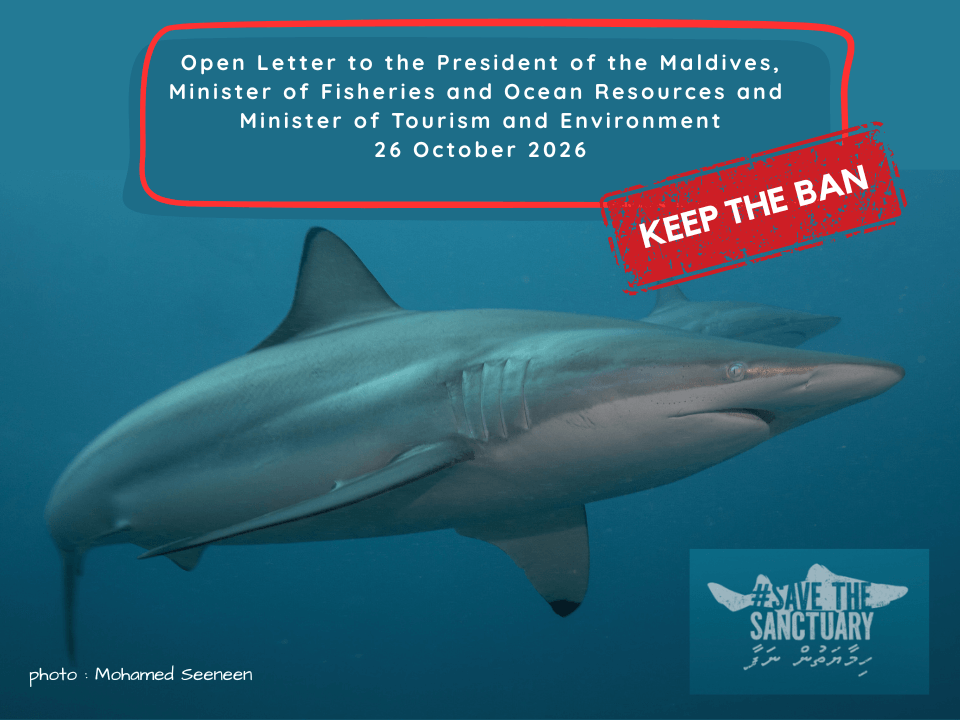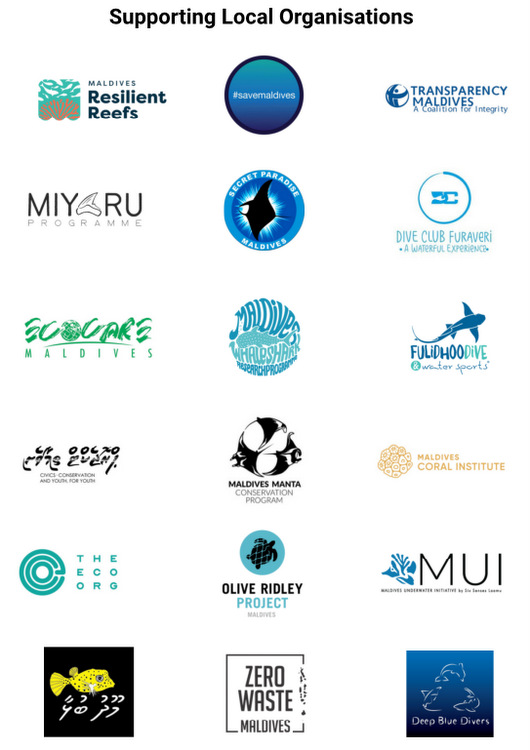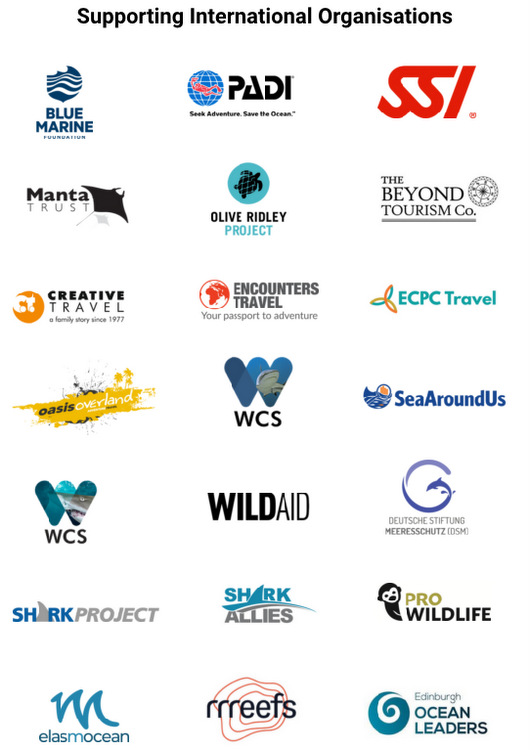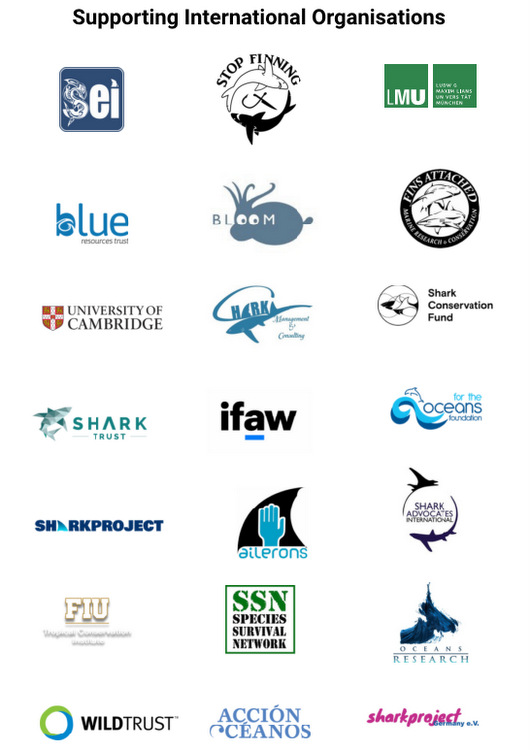ދިވެހިރާއްޖޭގެ ރައީސުލްޖުމްހޫރިއްޔާ އަދި މަސްވެރިކަމާއި ކަނޑުގެ ވަސީލަތްތަކާބެހޭ ވަޒީރަށާއި މިނިސްޓްރީ އޮފް ޓޫރިޒަމް އެންޑް އެންވަޔަރަމަންޓްގެ ވަޒީރަށް ފޮނުވާ ހުޅުވާލެވިފައިވާ ސިޓީ
ޢިއްޒަތްތެރި ރައީސުލްޖުމްހޫރިއްޔާ ޑރ މުޙައްމަދު މުޢިއްޒު، މަސްވެރިކަމާއި ކަނޑުގެ ވަސީލަތްތަކާބެހޭ ވަޒީރު އަލްފާޟިލް އަޙްމަދު ޝިޔާމް އަދި މިނިސްޓްރީ އޮފް ޓޫރިޒަމް އެންޑް އެންވަޔަރަމަންޓްގެ ވަޒީރު އަލްފާޟިލް ޠާރިޤު އިބްރާހީމަށް،
ވެދުން ސަލާމަށްފަހު ދަންނަވަމެވެ.
މިސިޓީގައި ސޮއިކޮށްފައިވާ ރާއްޖޭގެ އަދި ބައިނަލްއަޤްވާމީ ޖަމްޢިއްޔާތަކާއި ސައިންޓިސްޓުން ދިވެހި ސަރުކާރަށް ގޮވާލަނީ ކަށިމިޔަރުގެ މަސްވެރިކަން އަލުން ފެށުމުގެ މަސައްކަތް ހުއްޓާލުމަށެވެ. ހުށަހަޅާފައިވާ މެނޭޖްމަންޓް ޕްލޭނާއި ގަވާއިދު ފުންކޮށް ދިރާސާކުރުމަށްފަހު، އަޅުގަނޑުމެންނަށް ފާހަގަކުރެވެނީ މި ހުށަހެޅުމުން މަދު ބަޔަކަށް ކުޑަ މަންފާއެއް ލިބުނު ނަމަވެސް، ރާއްޖޭގައި އުޅޭ ކަށިމިޔަރުގެ އާބާދީތަކަށާއި، ދުޅަހެޔޮ ކަނޑެއްގެ މައްޗަށް ބަރޯސާވާ މަސްވެރިންގެ ދިރިއުޅުމަށް އަދި ދިވެހި އިޤްތިޞާދުގެ މައިގަނޑު ތަނބުކަމުގައިވާ ފަތުރުވެރިކަމުގެ ދާއިރާއަށްވެސް މިކަމުގެ ސަބަބުން އިއާދަ ނުކުރެވޭނޭވަރުގެ ގެއްލުންތަކެއް ލިބޭނެކަމެވެ.
ކަށިމިޔަރުގެ ބާވަތްތަކަކީ އޭގެ ޒާތުގައި އޭގެ މަސްވެރިކަންކުރުމުގެ ސަބަބުން ވަރަށްފަސޭހައިން މުޅިއާބާދީއަށް ނުރައްކާވާފަދަ ނާޒުކު ދިރުމެކެވެ. އެސޮރުމެންނަކީ ހެދިބޮޑުވެ ދަރިމައިވުމަށް ގިނަ ދުވަސްތަކެއް ހޭދަވާ، ރާއްޖޭގައި އުޅެން އެކަށީގެންވާ ސަރަޙައްދު ކުޑަކަމުގައި ބެލެވޭ ބާވަތްތަކެއް ކަމުން، އެސޮރުމެންގެ އާބާދީތަކަށް މަސްވެރިކަން ތަޙައްމަލެއް ނުކުރެވޭނެއެވެ. ރާއްޖޭގެ ތާރީޚުން އެނގޭ ގޮތުގައި މި މަސްވެރިކަމަކީ ވަރަށް ކުރު މުއްދަތެއްގެ ފައިދާ ލިބޭ، އަދި މަދު އަހަރުތަކެއްގެ ތެރޭގައި މަސްވެރިކަން ހީނަރުވާ “ބޫމް އެންޑް ބަސްޓް” މަސްވެރިކަމެވެ. އަންދާޒާކުރެވޭ ގޮތުގައި ކުރީގައި ކުރި މި މަސްވެރިކަމުގެ ސަބަބުން އެސޮރުމެންގެ އާބާދީ ވަނީ 97 އިންސައްތަ ދަށަށް ގޮސްފައެވެ. މި އާބާދީތައް އަނބުރާ އިއާދަވެފައިވާކަން ދައްކުވައިދޭ އެއްވެސް ސައިންޓިފިކް ހެއްކެއް ނެތެވެ. ދިވެހި ރާއްޖޭގައި އެސޮރުމެން އުޅެން އެކަށީގެންވާ މާހައުލު ހަނިވުމުގެ ސަބަބުން، ކުރީގައި ކުރި މަސްވެރިކަމުގެ ފަހުން ބާކީ ހުރި އެއްވެސް ސްޓޮކެއް ވާނަމަ އެއީ މަދު އަދަދެއް ކަމުން، އަލުން މަސްވެރިކަން ފަށައިފިނަމަ އެކަމެއް އެސޮރުމެންނަކަށް ތަހައްމަލެއް ނުކުރެވޭނެއެވެ. ރާއްޖޭގެ ކަނޑުތަކުގައި އުޅޭ ތިން ބާވަތުގެ ކަށިމިޔަރު ވަނީ އައި.ޔޫ.ސީ.އެން ރެޑް ލިސްޓުގައި “އެންޑެންޖަރޑް” ނުވަތަ ނެތިދިއުމުގެ ބިރު ހީވެފައިވާ ބާވަތްތަކުގެ ލިސްޓުގައި ހިމަނާފައެވެ. އެއްވެސް ސްޓޮކް އެސެސްމަންޓެއް ނެތި، ނުވަތަ މަދުވެގެން އާބާދީ އަލުން އާރާސްތުވާނެ ގޮތުގެ ދިގުރާސްތާ ރައްކާތެރި ލަފާކުރުމެއް ނެތި، މި މަސްވެރިކަން އަލުން ފެށުމަކީ ސައިންސުގެ އިލްމީ ނަޒަރުން ބަލާއިރު ކުރުން ރަނގަޅު ކަމެއް ނޫނެވެ. އަދި މިއީ މަސްވެރިކަމުގެ ޤާނޫނުގައި ބަޔާންކޮށްފައިވާ ރައްކާތެރިކަމުގެ ފިޔަވަޅުތައް އެޅުމަށާއި (ޕްރިކޯޝަނަރީ އެޕްރޯޗް)، ލިބެންހުރި އެންމެ ރަނގަޅު ސައިންސްޓިފިކް މަޢުލޫމާތުތަކުގެ މައްޗަށް ބިނާކޮށް މަސްވެރިކަމުގެ ވަސީލަތްތައް ބެލެހެއްޓުމަށް ލާޒިމުކުރާ މާއްދާތަކާއި ޚިލާފު ކަމެކެވެ (މަސްވެރިކަމުގެ ޤާނޫނު، 2 ވަނަ ބާބު، 3 ވަނަ އަދި 5 ވަނަ މާއްދާ).
މަސްވެރިކަމުގެ ޤާނޫނުގައި އަދި ހަމަ އެހެންމެ ލާޒިމުކުރަނީ މަސްވެރިކަމުގެ ވަސީލަތްތަކާ ގުޅޭ ނިންމުންތައް ނިންމުމުގައި ވީހާވެސް ގިނަ ދިވެހިރައްޔިތުން ހިމެނޭހެން ބައިވެރިވުން ޔަޤީންކުރުމަށާއި، ބައިވެރިވުމުގެ އުސޫލުން ނިންމުންތައް ނިންމުމަށެވެ (2 ވަނަ ބާބު، 5 ވަނަ މާއްދާ). އަދި ހެޔޮ ހިންގުމުގެ އުސޫލުތަކާ އެއްގޮތްވާ ގޮތުމެމަތިން ހާމަކަން ބޮޑު ގޮތެއްގައި ކަންކަން ކުރުމަށެވެ (2 ވަނަ ބާބު، 7 ވަނަ މާއްދާ). އެހެންނަމަވެސް، މުހިންމު މަސްލަޙަތުވެރިން ކަމުގައިވާ ކަނޑު މަސްވެރިންނާއި، ފަތުރުވެރިކަމުގެ އޮޕަރޭޓަރުންނާއި، މަދަނީ ޖަމްޢިއްޔާތަކާއި، މިނިވަން މަސްވެރިކަމާއި މިޔަރާއި ބެހޭ ސައިންޓިސްޓުން ބައިވެރިކޮށް މާނަވީ މަޝްވަރާތަކެއް މިނިސްޓްރީއިން ކޮށްފައި ނުވާކަމީ ވަރަށް ކަންބޮޑުވާންޖެހޭ ކަމެކެވެ. މަޝްވަރާކުރެވުނު ފަރާތްތަކަކީ ކޮބައިކަމާއި، އެ މަޝްވަރާތަކުގައި ދެކެވުނު ވާހަކަތަކާއި އަދި އިޖްތިމާޢީ-އިޤްތިޞާދީ އަސަރު ވަޒަންކުރުމުގެ ދިރާސާއެއްގެ އެއްވެސް ޢާންމު ރެކޯޑެއް ނެތެވެ. މީޑިއާގެ ރިޕޯޓުތަކުން އިނގޭ ގޮތުގައި މަސްވެރިން ހިމެނޭގޮތަށް ހދ. ކުޅުދުއްފުށީގައި މަޝްވަރާކުރެވުނު ފަރާތްތަކުން މި މަސްވެރިކަމަށް ތާއީދެއް ނުކުރެއެވެ (ލިންކް). ބްލޫ މެރިން ފައުންޑޭޝަން، މޯލްޑިވްސް ރެސީލިއަންޓް ރީފްސް އަދި މިޔަރު ޝާކް ޕްރޮގަރާމުން ހަދާފައިވާ މިނިވަން ސަރވޭއަކުން (އޮކްޓޯބަރު 2025؛ ނ=1،000) ދައްކާ ގޮތުގައި ޖަވާބުދިން މީހުންގެ 77 އިންސައްތަ މީހުން މި މަސްވެރިކަން އަލުން ފެށުމާ ދެކޮޅެވެ (ލިންކް). 19،000 އަށްވުރެ ގިނަ ދިވެހިންނާއި ބޭރު މީހުން ވަނީ މިކަން ނުކުރުމަށް ސަރުކާރަށް ގޮވާލާ ޕެޓިޝަންތަކުގައި ސޮއިކޮށްފައެވެ (ލިންކް).
ކަށިމިޔަރުގެ މަސްވެރިކަން އަލުން ފެށުމުން ޤާނޫނީ އަދި މާކެޓް ހިރާސްތަކެއްވެސް ކުރިމަތިވާނެއެވެ. މިއަހަރުގެ ނޮވެމްބަރާއި ޑިސެންބަރު މަހުގައި ބާއްވަން ހަމަޖެހިފައިވާ ސައިޓީސްގެ ކޮންފަރެންސް އޮފް ޕާޓީސް ގެ 20 ވަނަ ބައްދަލުވުމުގައި ސައިޓީސްގެ އެޕެންޑިކްސް 2ގައި ކަށިމިޔަރުގެ ބާވަތްތައް ހިމެނިއްޖެނަމަ، ރާއްޖެއިން ކަށިމިޔަރުގެ އެއްވެސް ބާވަތެއް އަދި ކަށިމިޔަރުން ހަދާފައިވާ ބާވަތްތައް އެކްސްޕޯޓުކުރުމަށް ސައިންސްގެ ހަރުދަނާ ހެކިތަކުގެ މައްޗަށް ބިނާކޮށް ތައްޔާރުކޮށްފައިވާ “ނޮން-ޑެޓްރިމެންޓް ފައިންޑިންގ” އެއް ބޭނުންވާނެއެވެ. މީގެއިތުރުން ދެމެހެއްޓެނިވިގޮތަކަށް ބޭނޭނެ އަދި ވިޔަފާރި ކުރެވޭނެ އެންމެ ގިނަ މިންވަރެއް ކަނޑައަޅަންޖެހެއެވެ. މިހާރުގެ ސްޓޮކްގެ މަޢުލޫމާތު އެއްވެސް ވަރަކަށް ނެތުމާއި، ކުރީގައި މަސްވެރިކަމުގެ ސަބަބުން މަދު އަހަރުތަކެއްގެ ތެރޭގައި އާބާދީ އިންތިހާއަށް ހީނަރުވެފައިވާތީ، ދެމެހެއްޓެނިވި ގޮތެއްގައި މި މަސްވެރިކަންކޮށް ކަށިމިޔަރުގެ އުފެއްދުންތައް ބޭރުކުރެވިދާނެކަމަށް ދައްކުވައިދޭ ޕޮޒިޓިވް ނޮން-ޑެޓްރިމެންޓް ފައިންޑިންގއެއް ހޯދުމަކީ ވަރަށް ނާދިރު ކަމަކަށް ވާނެއެވެ. އެހެންކަމުން، މި މަސްވެރިކަން އަލުން ފެށުމަށް އިންވެސްޓްކުރާ މަސްވެރިންނަށް ސައިޓީސްގެ ފިޔަވަޅުތައް ތަންފީޒުކުރަން ފެށުމުން ކުރިމަތިވާނެ ވިޔަފާރީގެ ދަތިތަކުގެ ސަބަބުން އެ މީހުންގެ މަސައްކަތް އިޤްތިޞާދީ ގޮތުން ކުރިއަށް ގެންދެވޭ ގޮތް ނުވެ ބޮޑެތި މާލީ ގެއްލުންތަކާ ކުރިމަތިލާން ޖެހިދާނެއެވެ. އަދި މިހާލަތުގައި އެކްސްޕޯޓުކުރުން ކުރިއަށް ގެންގޮސްފިނަމަ ސައިޓީސްއާ ޚިލާފުވެ “ރިވިއު އޮފް ސިގްނިފިކަންޓް ޓްރޭޑް ޕްރޮސެސް” އެއް ފެށި، ވިޔަފާރި ހުއްޓުވުން ނުވަތަ އެކްސްޕޯޓު މަނާކުރުން ފަދަ ފިޔަވަޅުތައް އެޅިގެންދިއުމަކީ ވަރަށް ގާތް ކަމެކެވެ. މިކަމުގެ ސަބަބުން މަސްވެރިންނާއި އެކްސްޕޯޓަރުން ޤާނޫނީ ގޮތުން ޔަޤީންކަން ނެތް ޙާލަތަކަށް ވެއްޓި، އިންވެސްޓްމަންޓްތައް ގެއްލި، އަދި ވިޔަފާރިކުރުމުގެ ދަތިތަކަކަށް ހުށަހެޅިގެން ގޮސްދާނެއެވެ. މިއަހަރު ފްރާންސްގެ ނީސްގައި ބޭއްވުނު ޔޫއެންއޯސީ3 ގައި “ގްލޯބަލް ކޯލިޝަން ޓު ހޯލްޓް ދަ އެކްސްޓިންކްޝަން އޮފް ތްރެޓަންޑް ޝާކްސް އެންޑް ރޭސް” ފެށުމުގެ ރަސްމިއްޔާތުގައި މިނިސްޓަރ ތާރިޤް އިބްރާހީމް ފާހަގަކުރެއްވި ފަދައިން، ދިވެހިރާއްޖެއިން ވަނީ މިޔަރަށް ހިމާޔަތްތެރިކަން ފޯރުކޮށްދޭ ފުރިހަމަ “ޝާކް ސެންކްޗުއަރީ” އަކަށް އިލްތިޒާމްވެފައެވެ. ނަމަވެސް ޤަވާޢިދުތަކާ ޚިލާފަށް ކުރެވޭ ވިޔަފާރިއަކުން ބައިނަލްއަޤްވާމީ ފެންވަރުގައި ދިވެހިރާއްޖެއިން ގެންގުޅޭ ޙިމާޔަތްކުރުމުގެ ސިޔާސަތަށް އުނިކަން އަންނާނެއެވެ.
ހުށަހަޅާފައިވާ މެނޭޖްމަންޓްގެ ފިޔަވަޅުތައްވެސް އެކަށީގެންވާ ވަރަށްވުރެ ދެރައެވެ. އެގޮތުން، ފިޔަވަހިތަކަކަށް ބަހާލައިގެން މަސްވެރިކަން ކުރުމުގެ މިންވަރު ކަނޑައެޅުމެއް، ވަކިވަކި އުޅަނދުތަކުން ހިފޭނެ މިންވަރު ނުވަތަ މަސްވެރިކަން ކުރެވޭނެ މިންވަރުގެ ލިމިޓެއް ނެތެވެ. އަދި ލޭނު ބޭނުންކުރުމުން އަމާޒު ނުކުރާ ބާވަތްތަކުގެ މިޔަރު ހިފިދާނެކަން ޤަބޫލުކޮށްފައި ވީނަމަވެސް ބައިކެޗް މޮނިޓަރކޮށް ހިސާބު ބެލެހެއްޓޭނެ ސާފު، މިނިވަން ގޮތެއްގައި ޔަޤީންކުރެވޭނެ ނިޒާމެއްވެސް ނެތެވެ.
ކުރީގައިވެސް ލޭނު ބޭނުންކޮށްގެން ކުރި މި މަސްވެރިކަމުގައި އެހެނިހެން ބާވަތްތަކުގެ މިޔަރު ބޭނިފައިވާކަން ހިއްސާކޮށްފައި ވީހިނދު، ބުޅިތަކުގައި އެންލާފައި ކަނޑުގެ ފުން ހިސާބުތަކުގައި އޮލަނބަށް އަޅާ ލޭނުފަތިން، އަމާޒުނުކުރާ ބާވަތްތަކުގެ “ބައިކެޗް” ވަރަށް ބޮޑަށް މިފަދަ މަސްވެރިކަމުގައި އިތުރުވާނެއެވެ. ރާއްޖޭގެ ދޮށީގެ ކަނޑުމަސްވެރިކަމަށް އެހާމެ މުހިންމު އޮއިވާލި މިޔަރު (ސިލްކީ ޝާކް) އަދި ކުރިއަރަމުންދާ ޑައިވިންގ އިންޑަސްޓްރީގެ އަސާސް ކަމުގައިވާ ނެތިދިއުމުގެ ބިރު ހީވެފައިވާ “ޕެލާޖިކް” މިޔަރުގެ ބާވަތްތައް މީގެތެރޭގައި ހިމެނެއެވެ. ދިވެހިރާއްޖެއަކީ ޖަޒީރާ ގައުމަކަށް ވުމުން، މީގެ ކުރީގައި ހެދިފައި ހުރި މެނޭޖްމަންޓް ޕްލޭންތައް ތަންފީޒުކުރުމުގައި ގޮންޖެހުންތަކަކާ ކުރިމަތިވެފައިވާކަން ފާހަގަކުރަމެވެ. މިކަމުގެ ސަބަބުން، ހުށަހެޅިފައިވާ އޮނިގަނޑުގެ ދަށުން ޢަމަލީ ގޮތެއްގައި އެކަށީގެންވާ މިންވަރަކަށް މޮނިޓަރކޮށް، ކޮންޓްރޯލްކޮށް އަދި ސަރވެއިލަންސް ބެލެހެއްޓިދާނެކަމާމެދު ވަރަށް ބޮޑެތި ޝައްކުތަކެއް އުފެދެއެވެ. ލަފާދޭ ކޮމިޓީ އެކުލަވާލުމަށް ރާވައިފާ ގޮތަށް ބަލާއިރު، އޭގައި ހިމަނާފައިވަނީ ކޮންޒަވޭޝަން ދާއިރާގެ އެންމެ މަންދޫބެކެވެ. މިހެންކަމުން ޒިންމާދާރުގޮތެއްގައި ކަންކުރުމަށް (ރެސްޕޮންސިބަލް ގަވާނަންސް) ބޭނުންވާ މިނިވަން ސައިންޓިފިކް ބެލުން ނުވަތަ މަސްލަޙަތުވެރިންގެ ބެލެންސް ހޯދިދާނެ ގޮތެއް ނެތެވެ.
އިސްވެ ދެންނެވުނު ސައިންޓިފިކް، އިޖްތިމާޢީ-އިޤްތިޞާދީ އަދި ހެޔޮލަފާ ސިޔާސަތު ހިންގުމާ ގުޅޭ ކަންބޮޑުވުންތަކުގެ އަލީގައި، ތިރީގައިވާ ޖަމްޢިއްޔާތަކާއި މާހިރުން އިޙްތިރާމާއެކު ދިވެހި ސަރުކާރަށް އަންނަނިވި ކަންކަން ހުށަހަޅަމެވެ:
- ކަށިމިޔަރުގެ ސްޓޮކް އެސެސްމަންޓެއް ނެތުމާއި، މި ދިރުންތަކުގެ ނާޒުކުކަމާއި، އާބާދީ އަވަހަށް ދަށަށް ދިޔުމުގެ ތާރީޚީ ރެކޯޑު އޮތުމާއި، އަދި މޫސުމަށް އަންނަ ބަދަލުތަކުގެ ސަބަބުން ކަނޑުގެ މާޙައުލަށް ކުރިމަތިވަމުންދާ އިތުރު ގޮންޖެހުންތަކަށް ރިއާޔަތްކޮށް، މަސްވެރިކަމުގެ ޤާނޫނުގެ (2 ވަނަ ބާބު، 3 ވަނަ މާއްދާ) ދަށުން ލާޒިމްކުރާ ފަދައިން “ޕްރިކޯޝަނަރީ” ފިޔަވަޅު އެޅުމާއިއެކު ކަށިމިޔަރުގެ މަސްވެރިކަން އަލުން ފެށުމުގެ ރޭވުންތައް ވަގުތުން ހުއްޓާލުމަށް
- ދިވެހި ކަނޑު މަސްވެރިންނާއި، މަދަނީ ޖަމްޢިއްޔާތަކާއި، މުސްތަޤިއްލު ސައިންޓިސްޓުނާއި، ވިޔަފާރިވެރިން އަދި ފަތުރުވެރިކަމުގެ ދާއިރާގެ އޮޕަރޭޓަރުން ހިމެނޭގޮތަށް (މަސްވެރިކަމުގެ ޤާނޫނުގެ 2 ވަނަ ބާބު، 5 ވަނަ މާއްދާއާ އެއްގޮތްވާ ގޮތުގެމަތިން) ފުރިހަމައަށް ހާމަކަން ބޮޑު، ލިޔެކިޔުމުން ރެކޯޑުކުރެވޭ އަދި އެންމެން ހިމެނޭގޮތަށް މަޝްވަރާކުރުން ކަށަވަރުކުރުމަށާއި، މި ހުށަހެޅުމާ ގުޅޭ އަދި އެއާ ގުޅިގެން ނިންމާ ނިންމުންތަކާ ގުޅޭ އެންމެހައި މަޢުލޫމާތާއި، މަޝްވަރާތަކުގެ ރެކޯޑުތައް އަދި ދިރާސާތައް ޢާންމުކުރުމަށް.
- ‘2010 ގައި ޤާއިމްކުރެވުނު ދިވެހިރާއްޖޭގެ ޝާކު ސެންކްޗުއަރީއަކީ ސަރަޙައްދީ އަދި ދުނިޔޭގެ ފެންވަރުގައި ކަނޑުގެ މާޙައުލު ހިމާޔަތްކުރުމާއި ދެމެހެއްޓެނިވި ގޮތެއްގައި ކަނޑުގެ ވަސީލަތްތައް ބެލެހެއްޓުމުގެ ނަމޫނާއެއް ކަމުގައި އޮތްއޮތުމާއި، ޤައުމުގެ ނޫ އިޤްތިސާދަށް މުހިންމު ޙިއްޞާއެއް ކުރާ ކަމެއްކަމުގައި ފުރިހަމައަށް ބަލައިގަނެ ދިވެހިރާއްޖެއިން މިކަމުގައި ދީފައިވާ އިލްތިޒާމު އަލުންވަރުގަދަކޮށް ދެމެހެއްޓުމަށް.
ކަނޑުގެ ދިރުންތަކުގެ މުއްސަނދިކަމާއި އާމްދަނީ ހޯދުމުގެ ވަސީލަތްތައް ރައްކާތެރިކޮށް، ރާއްޖެއަކީ ދުނިޔޭގެ ފެންވަރުގެ ފަތުރުވެރިކަމުގެ މަންޒިލެއްގެ ގޮތުގައި އޮތް އޮތުން ދެމެހެއްޓުމަށް، ސައިންސްގެ މައްޗަށް ބިނާކޮށް އަޅާ ފިޔަވަޅުތަކަށް ފުރިހަމަ އެއްބާރުލުން ދިނުމަށް މި ސިޓީގައި ސޮއިކޮށްފައިވާ ފަރާތްތަކުން ތައްޔާރަށް ތިބީމެވެ. ޤައުމުގެ ދުޅަހެޔޮކަމާއި، ދުނިޔޭގެ ފެންވަރުގައި ފާހަގަކުރެވޭ ކަނޑުމަހުގެ ބާވަތްތަކުގެ މަސްވެރިކަމުގެ ދެމެހެއްޓެނިވިކަން ބިނާވެގެންވަނީ ދިރުންތަކުގެ ސިންދަފާތު ދުޅަހެޔޮ، އަދި ވިލުންވެރި ކަނޑެއްގެ މައްޗަށެވެ. އަޅުގަނޑުމެންގެ އިލްތިމާސްއަކީ އިޔާދަ ނުކުރެވޭނެފަދަ ގެއްލުމެއް ލިބުމުގެ ކުރިން މިހާރުން މިހާރަށް މިކަން ހުއްޓާލުމެވެ.
އިޙްތިރާމާއެކު،

Open Letter to the President of the Maldives, Minister of Fisheries and Ocean Resources and Minister of Tourism and Environment
26 October 2025
To: His Excellency President Dr. Mohamed Muizzu, Honourable Minister of Fisheries and Ocean Resources Mr. Ahmed Shiyam, and Honourable Minister of Tourism and Environment Mr. Thoriq Ibrahim,
The undersigned 60 local and international organisations and 50 scientists urgently call on the Government of the Maldives to halt plans to re-establish a gulper shark fishery. We have carefully reviewed the draft management plan and regulation and concluded that the proposal would provide minimal benefits to a small number of actors while causing irreversible harm to local populations of gulper sharks and to fishers who rely on a healthy ocean for their livelihoods, as well as to the tourism sector that underpins the Maldivian economy.
Gulper sharks are intrinsically vulnerable to overexploitation. Their slow growth and reproductive rates, and the restricted availability of suitable habitats in Maldivian waters create a population dynamic that cannot sustain fishing pressures. The historical record in the Maldives shows a rapid boom-and-bust for this fishery, with collapses occurring within only a few years, and there is no scientific evidence that populations have recovered from the estimated 97% decline caused by overfishing in the past. Given the limited habitats, any remaining stocks are likely small and unable to withstand renewed exploitation. All three gulper shark species present in Maldivian waters are listed as Endangered on the IUCN Red List. Without a stock assessment, or at minimum a precautionary, multi-decade recovery projection, reopening this fishery is both scientifically unsound and contravenes with the Fisheries Act’s requirement to apply the precautionary approach and manage resources using the best available science (Fisheries Act, Chapter 2, Clauses 3 and 5).
The Fisheries Act also requires broad participation by Maldivians in decisions affecting fisheries resources and mandates participatory decision-making (Chapter 2, Clause 5), good governance and transparency (Chapter 2, Clause 7). It is therefore deeply troubling that the Ministry appears not to have conducted meaningful consultations with key stakeholders, including local tuna fishers, tourism operators, civil society organisations and independent fisheries or shark scientists. No public records exist of who was consulted, the substance of those consultations, or any socio-economic impact assessments. Media reporting indicates that stakeholders consulted in Haa Dhaalu Kulhudhuffushi—including fishers—did not support this fishery (link). Independent polling by Blue Marine Foundation, Maldives Resilient Reefs and the Miyaru – Shark Programme (October 2025; n=1,000) found 77% of Maldivians opposed to resuming this fishery (link). More than 19,000 local and international signatories have added their names to petitions urging the Government to abandon this proposal (link).
Reinitiating the gulper shark fishery also poses substantial legal and market risks. If gulper sharks are listed on CITES Appendix II at the upcoming COP20 meeting in November-December 2025, exports of any gulper shark and their derivatives would require a scientifically grounded Non-Detriment Finding (NDF) as well as catch and trade quotas. In the absence of current stock data, and given past population collapses within only a few years, obtaining a positive NDF for sustainable international trade is highly unlikely. Fishers who invest to reinitiate this fishery would therefore risk severe financial losses once CITES measures take effect, as resulting trade restrictions could render their operations economically unviable. Continued exports under these conditions would risk non-compliance with CITES and could trigger a Review of Significant Trade process, potentially leading to trade suspensions or export bans. This outcome would expose fishers and exporters to regulatory uncertainty and stranded investments. As Minister Thoriq Ibrahim noted at the launch event of the Global Coalition to Halt the Extinction of Threatened Sharks and Rays (link) at UNOC3 (Nice, 2025), the Maldives has committed to a comprehensive shark sanctuary—an international conservation stance that would be compromised by non-compliant trade.
The proposed management measures themselves are inadequate. They include no phased fishing effort, no vessel-level catch or effort limits, and no clear, independently verifiable system to monitor and account for bycatch, despite acknowledging that other shark species have historically been taken by longline gear. As a vertical bottom-set longline fishery using baited hooks, this fishery would inevitably cause substantial bycatch of other sharks, including silky sharks (crucial for the Maldives’ one-by-one tuna fishery) and other threatened pelagic sharks that underpin the growing dive industry. Given the Maldives’ geographical dispersion, previous management plans have proven difficult to implement and enforce, raising serious doubts about the practical feasibility of effective monitoring, control and surveillance under the proposed framework. The advisory board’s composition consisting of only a single conservation representative fails to provide the independent scientific scrutiny or stakeholder balance necessary for responsible governance.
In light of the scientific, socio-economic, and governance concerns outlined above, the undersigned organisations and experts respectfully recommend the Government of the Maldives to:
• Immediately suspend any plan to reopen gulper shark fishing and apply the precautionary principle as required under the Fisheries Act (Chapter 2, Clause 3), acknowledging the absence of stock assessments, the species’ high vulnerability, the historical record of rapid population collapse, and increasing ocean pressures from climate change.
• Ensure fully transparent, documented and inclusive stakeholder consultations that include local fishers, civil society, independent scientists, market actors and tourism operators (in line with Chapter 2, Clause 5 of the Fisheries Act) and publish all data, consultation records and analyses related to this proposal and any decisions thereon.
• Reaffirm the Maldives’ commitment to its Shark Sanctuary, established in 2010, as a regional and global model of marine conservation and sustainable ocean governance and as a vital contributor to the country’s blue economy.
The undersigned stand ready to support science-based measures that protect marine biodiversity, safeguard livelihoods, and preserve the Maldives’ tourism reputation. The nation’s well-being and the sustainability of its world-class tuna fisheries depend on healthy, biodiverse, and resilient oceans. We urge you to act now to prevent irreversible harm.
Sincerely,
Supporting Local and International Organisations, and Supporting Shark/Fisheries Scientists.
Supporting Shark and Fisheries Scientists
- Aminath Shaha Hashim, Executive Director, Maldives Resilient Reefs
- Maeesha Mohamed, President/ Co-Founder, Maldives Manta Conservation Programme
- Hamna Hussain, Co-Founder and Vice President of Miyaru – Shark Progreamme, Shark Conservationist
- Dr Judith Brown, Projects Director, Blue Marine Foundation
- Max Bello, Marine Policy Specialist, Blue Marine Foundation
- Arzucan Askin, Co-founder of Miyaru – Shark Programme, National Geographic Explorer, Rolex Scholar
- Dr Iris Ziegler, Head of Fisheries Policies and Ocean Advocacy at German Foundation for Marine Conservation
- Brittany Finucci, Adjunct Researcher, University of Tasmania, Australia
- Luke Warwick, Director, Shark and Ray Conservation, Wildlife Conservation Society
- Daniel Fernando, Co-Founder and Director, Blue Resources Trust
- Stan Shea, Marine Programme Director, BLOOM Association Hong Kong
- Guy Stevens, Chief Executive/ Founder, Manta Trust
- Alex Antoniou, PhD., Chief Executive/ Founder, Fins Attached Marine Research and Conservation
- Fernando Reis, Executive Director, Sharks Educational Institute
- Juan Martín Cuevas, Coordinator, Sharks and Rays of Patagonia, Wildlife Conservation Society Argentina
- Carlos J Polo Silva, Director, Sharky Management & Consulting
- Dr Cassandra Rigby, Adjunct Senior Research Fellow, James Cook University
- Lee Crockett, Executive Director, Shark Conservation Fund
- Paul Cox, CEO, Shark Trust
- Dr. Martina Gaglioti, Marine researcher and educator, IUCN CCC, CEC, WCPA Member
- Matthew Collis, Senior Director, Policy, International Fund for Animal Welfare (IFAW)
- Jorge Serendero, Director, For the Oceans Foundation, OOWC One Ocean Worldwide Coalition
- Pamela Nylund, Head of International cooperation, SHARKPROJEKT international
- Matthieu Lapinski, President, AILERONS
- Sonja Fordham, President, Shark Advocates International
- John Baker, President, WildAid
- Mark Bond, Research Assistant Professor, Florida International University
- Callum Roberts, Professor of Marine Conservation Centre for Ecology and Conservation, University of Exeter
- Dr. Julia Spaet, Shark Scientists, rrreef and University of Cambridge
- Stuart Pimm, Doris Duke Professor of Conservation, Duke University
- Dr Julie Hawkins, Ecology and Conservation, University of Exeter
- Dr Robert S. Steneck, Professor Emeritus of Oceanography, Marine Biology and Marine Policy, University of Maine
- Dr Enrico Gennari, Director – Oceans Research Institute, Honorary Research Associate – the South African Institute for Aquatic Biodiversity (SAIAB), Research Associate – Department of Ichthyology and Fisheries Science (DIFS), Rhodes University
- Vyv Summers, Senior Research Technician at the Marine Futures Lab, The University of Western Australia
- Fabián Pina Amargós, Marine Scientist with Research and Management on Sharks and Rays
- Dr. Lauren Dykman, Postdoctoral Fellow, University of Victoria/ Restoration Science Lead, The Kelp Rescue Initiative
- Claire Nouvian, Founder & Director of BLOOM
- Dr. Yvonne Sadovy, University of Hong Kong (ret.)/ IUCN Groupers and Wrasses Specialist Group Chair
- Dr. Gonzalo Pérez-Rosales, Hong Kong University of Science and Technology
- Dr. Katrina Himpson, BVM&S MRCVS
- Amy Cartwright
- Dr. Jean M Harris, Strategic Ocean Lead, WILDOCEANS Programme
- Taïme Smit Pellure, Co-funder and President, Acción Océanos
- Robert S. Steneck, Professor Emeritus of Oceanography, Marine Biology and Marine Policy, School of Marine Sciences, University of Maine
- Ellen Pikitch, Endowed Professor of Ocean Conservation Science Institute for Ocean Conservation Science, School of Marine and Atmospheric Sciences, Stony Brook University
- Prof. Amanda Vincent, Ph.D. FRSC, Director, Project Seahorse; Professor, Institute for the Oceans and Fisheries; Chair, IUCN SSC Marine Conservation Committee; Chair, IUCN SSC Seahorse, Pipefish and Seadragon Specialist Group
- Paolo Cortelezzi, PhD Candidate – Marine Futures Lab, The University of Western Australia
- Tamara Figueredo Martín, Environmental economist Scientist with research and management on sharks and rays
- Alfredo Quarto, Program and Policy Director/Co-Founder, Mangrove Action Project
- Jim Enright, CBEMR Trainer & Advisor, Mangrove Action Project





